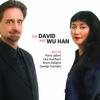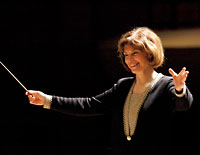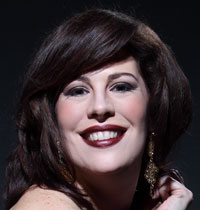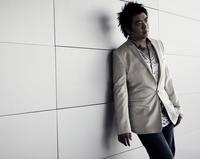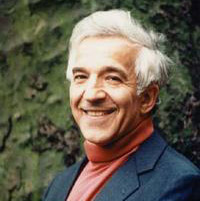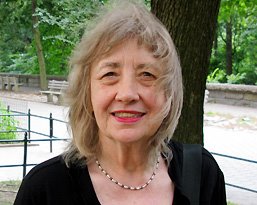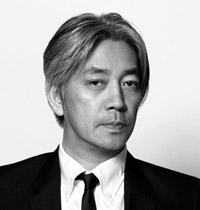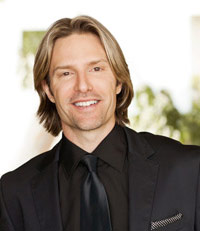2010 Roundup / Phillip Glass Challenge: December 13, 2010
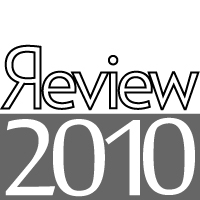
Happy Holidays from Classical Archives! To celebrate the holiday season, and our first full year of service, we are pleased to present the Classical Archives 2010 Roundup - placing a spotlight on some of our favorite Features presented through the year. During 2010, Classical Archives scored a good number of exclusive interviews with some of today's most active and creative classical artists and composers, conducted by Artistic Director, Nolan Gasser. This roundup features linked excerpts of ten of our favorite interviews - with soloists Hilary Hahn, Lang Lang, Sondra Radvanovsky, David Finckel, and Wu Han; conductors Vladimir Ashkenazy and JoAnn Falletta; and composers John Corigliano, Ryuichi Sakamoto, Gloria Coates, and Eric Whitacre. To accompany these interview excerpts is a 2-hour Playlist with music from these great artists and composers; as well as a sample of videos.
As another holiday season treat, we are very pleased to feature famed American composer Philip Glass' newest recording, his 2nd Violin Concerto, subtitled 'The American Four Season', which comes with a Special Challenge to Classical Archives visitors to name the seasons - and enter a chance to win a signed copy of the CD by the composer. Finally, we are pleased to offer all visitors to Classical Archives three Free Downloads - two holiday tracks from our friends at Naxos, and one track from the new Philip Glass CD. Happy holidays, and enjoy the roundup!
 Loading, please wait...
Loading, please wait...
2010 was a great year for Classical Archives interviews. Through our close connections with our label partners and top classical music agencies - shepherded by our industry insiders Joe McKesson and Jonathan Gruber - we've been able to schedule in-depth conversations between Artistic Director Nolan Gasser and some of today's most vibrant and influential classical music personalities. Dr. Gasser goes deep in preparing these discussions, aiming to get past the obvious questions into the heart of the musical and aesthetic thinking that informs the interviewee's projects and achievements. The result is a provocative conversation that reveals insights into the creative process and larger aspirations of these seminal figures of our day. It is in part because of the depth of our interviews that Classical Archives is granted access to so many top-tier artists - including those who elude other media outlets. We hope that you will make reading these interviews a regular part of your classical music life, and that you will share your thoughts and reactions in the Comments section. And stay tuned for some more stellar interviews in 2011!
Below are brief excerpts of some of our favorite interviews of 2010, each preceded by a brief intro, and provided with direct links to the full interview and the interviewee's page on our site. And don't forget to check out the Best of 2010 Interviews Playlist for some great tracks from these outstanding soloists, conductors, and composers.
Nolan Gasser: Now, building upon what you said with regard to your First Symphony, I was struck, in reading the liner notes, how much a non-musical narrative or storyline guides the work - which makes sense, given the theme of the work [a tribute to friends afflicted by AIDS]. This too gets into your architectural approach, I would imagine. Can you talk a bit about how this approach created a departure from earlier works, and how it has evolved for you over the years?
John Corigliano: Well, of course, when I started composing and my first pieces like my Violin Sonata or my Piano Concerto [1968] or Tournaments [1965], I was composing using architectures that had been used for many years, because most composers who are composing in a somewhat tonal manner, tend to use the classical architectures that really started with Haydn and developed through the Classical period. And that's what the symphony and the concerto and the string quartet and all of these things are. They are basically, the first movement is always Sonata Form, the second movement is always a slow movement, which could be Theme and Variations or it could be ternary form or whatever. The third movement is often usually a Minuet or Scherzo and the last movement can be many things, a Rondo, or Sonata Form or other things. So, composers have been doing that for quite some time. And when I started composing I did variants of that, just like any other young composer would do. But, I started thinking about all of that and I asked myself, "Why am I using an 18th century form? What about these forms make them really work?" And what makes them really work is the understanding that the composers of those days had - of the yin and the yang of the familiar and the new. All these forms are combinations of something you know that is played again, and something new for variety. And the simplicity of that idea is really amazing, because it's not a musical thing - it's a human thing.
If, in fact, we work seven-day weeks and we work week after week, by the second or third week we want something that is variety - there's too much repetition. If we go to Europe and every day we're in a different city and we're traveling around, by the third week you'll say what every weary traveler says, "I want to go back home and get back to my job, and have a little more repetition, because there's just too much new information being fed to me; I had just too much 'new'". So, this is not music, this is life! These are human beings. And music takes those and builds them into structures. And the way we do that, is we find that if you take something you know, something that you have, and you repeat it, it becomes familiar. But if you repeat it too much, then it becomes overly familiar and boring. Now minimalism is an example of an art form that took that to its extreme and said, "No, we will be boring because that's what we want to be."
NG: [laughter] And indeed, I've heard you express some criticism of minimalism for it's excessive repetition, lack of architecture, and so forth; and yet you've also avoided a rigid application of the purely intellectual approaches of serialism, and related techniques that came out of your formative years. Instead you've created your own distinct aesthetic based, as you say, on a "human" orientation...
JC: Right. You see, minimalism really started out as trance music; it was music in which you meditated, which you did not listen to the music the acute way you do when you sit in a hard back chair in a concert hall and listen to music. But instead, you meditate with your eyes closed, and your mind drifts off to something else while the music is playing. And that's perfectly good. That's a good function for minimalism. Then the 12-tone and serial composers never repeated anything; absolutely never! And their idea was: repetition is needless. We say something and we go on. Well, again, the mind encompasses the first few seconds of a musical piece like that, and after a few minutes of it, the mind turns off. And now we just listen to the sounds, whether they're nice, or not nice. But we don't have any idea of what's happening because intellectually we're left out of the process.
So, both of those extremes were unsatisfying to me, and I had to find a way to build pieces that had in them the kinds of repetitions and the kinds of new material that excited me. And each piece I wrote was built upon those premises. Some were built with things that were generated by emotional responses, like my Clarinet Concerto - which was the first piece written for the New York Philharmonic, an orchestra I grew up with. Some were intellectual ideas, like my Oboe Concerto, in which there are five movements of five different aspects of the oboe - things that only an oboe can do. And I did that because I felt that most oboe concertos basically were concertos with "singing" instruments; and that any flute or clarinet or violin could play an oboe concerto. But what is special about the oboe? To do that, I kept listing oboe things and ideas until I had found five things that could form a concerto - and built it that way. So you see, each piece has a different way of being generated. And it's kind of interesting - it's a little scary too - to start a piece, because you really don't have any master plan. You have to make the master plan. You don't have Sonata Form to fall back on, or you don't have a technique that says: "there is no form" to hang on to. You say, "No, I must create one." And that's what I'm doing right now. I'm in the process of thinking up something for a new piece and at the moment, it's all very cloudy. I don't have the answers.
Nolan Gasser: So staying on J.S. Bach a bit - you've stated that his music has always been a touchstone for you - keeping your playing honest - and that for many years you were playing Bach's music every day. Is this still generally true? And have you gained any new insights on what playing Bach does for you as an artist and as a performer?
Hilary Hahn: Yes, in fact, I still do play it most every day. It's never been part of a "religious" ritual, or anything; it was more that I perform Bach's music so much that I'm always practicing it. When I was a student, I was always preparing it for my lessons because my teachers liked me to work on it constantly - mostly the solo violin repertoire in that case. And now, I play a lot of Bach encores for my concerts - that is, movements from the solo sonatas and partitas, following orchestra performances. I like to use those particular movements as well for things like school visits; I've played them at weddings and memorial services... it seems to work in all contexts - though granted, you have to tailor what you're playing to the occasion. Plus I've played them on TV and radio... So, there's always some occasion for which I'm preparing Bach. It's great to have the goal of performance be the reason to work on something everyday. It makes you really push yourself instead of just doing it as a kind of a hobby; it really makes me focus my efforts to try to figure this stuff out. I think that the "touchstone" part of it has a lot to do with the solo repertoire, because it takes a lot of technical precision, but it can never sound technically difficult. The musical part of it is really challenging: to balance all the lines at once, and to do that within the confines of the technical writing. So, you can't skimp with the sonatas and partitas at all, in any way; you really have to have done everything there is to do with your preparation in order to make it work - you can't fake your way through it. Of course, I try not to fake my way through anything, but with Bach it's particularly obvious if it's not coming together on a particular day.
NG: It certainly forces you to be honest with yourself, as well as your audience, to get beyond those technical issues - and to arrive at what makes Bach's music so magical, the beauty and the inspiration contained within the music.
HH: Yes, and I have to say too, that one thing that's really challenging as a performer is working not only on Bach, but on all different repertoires - for the music I do is so varied. In a way, I think the variety is really what keeps me in shape. Because, just as I start to settle into one way of playing, or one composer's repertoire, then I go straight into another's. For example, I've been playing Jennifer Higdon's Violin Concerto, and now I'm playing the Prokofiev 1st [Violin Concerto No.1 in D, Op.19] and the Sibelius [Violin Concerto in D-, Op.37] on the same tour. And, from the extensions of the hand positions and the kind of agility required in the Higdon concerto, to the compressed hand positions in the Prokofiev, to the really dark, drawing quality of the Sibelius - at first I think that I know what I'm doing, but then I start another piece that I already know and I think, "Gosh, where's my playing? I thought I was doing alright last week, what's going on?" [laughs] And, it's just this constant challenge of playing these composers with different musical languages, from different eras, with different influences, and all of that. And so I keep coming back to Bach - again, because I play his music so often - and it's kind of a constant in all that variety, and it keeps my playing more honest than if I were to only play Bach all the time.
Nolan Gasser: So, let's move on a bit to some of the other hats that you wear. You two have rather become authorities on the ups-and-downs of chamber music performance in America, especially through your capacity as Artistic Directors of both the Chamber Music Society of Lincoln Center [CMS] and Music@Menlo [in Menlo Park, California] - as well as through your involvement at various festivals such as Aspen and Savannah. Now, Wu Han, you wrote in a recent blog of the sense of pessimism and concern that reigned at a recent APAP [Association of Performing Arts Presenters] conference, and of your frustration with a seeming willingness on the part of some of the presenters to compromise quality for the sake of "out-of-the box" strategies to sell tickets. Can you elaborate on this sense, and maybe give us a sense of what strategies you two are finding most successful to keep the performance well attended?
Wu Han: I think the best strategy is to be really honest about what you are trying to do - and to bring your audience as close as you can to the music itself, which is the core of the magic. For instance, some presenters would want to tell people, "If you come to the concert, you can relax, you can text-message, you can have a night-out with your girlfriend, you can have a glass of wine and a lovely dinner..." But none of these things is why anyone wants to go to a concert - to be touched and moved, and to walk away feeling inspired. Those other things may make it nice and convenient, but it's not really the true reason we all devote our lives to this art form.
I hear this kind of talk all the time, but it's not truly bringing people to the music itself in the deepest way; and I much prefer that my audience understand this from the start. A case in point is with Music@Menlo: I can remember in our first year [2003], the marketing department asked us "Can we say in the announcement: 'Come relax and enjoy an evening of beautiful music?'" And we said, "No, don't relax! If they want to relax, they should go to see a movie, or go fishing." No, coming to a concert is great exercise - a great challenge; you'll know more about the music and you'll get more out of it. I've never heard any of my friends that are really devoted to music say that they had "a relaxing experience".
NG: No, it's quite the contrary: when it's a success, a concert is the most intense and stimulating experience, where people come out inspired to go paint the house or something...
WH: Exactly! That's the kind of the marketing we need. And how can we bring people to that point, to that true point of inspiration? I would love to find that magic bullet. If this is our goal, what do we need to do? I don't think it's to encourage people to text-message, or join a social network. I understand that this is a good way to build a community, but in the end, that's not what we want to do. I think that was my point when I was listening to some of these conversations: as fascinating and as interesting as they are, the true fascination has to be the music!
NG: And I assume that you made that point in your capacity as a panelist at the conference?
David Finckel: Well, I wasn't there to witness it, but I assume she did [laughs]. You know, we were educated in music - and to a certain extent in life - by a generation of musicians who felt so deeply about the music they played... Do you remember in the movie Titanic, when the boat went down? Well, the orchestra just sat up straight, continued playing, and went down with the ship - and the musicians who educated us felt about music like that! Their generation was buttressed, preserved, and augmented by presenters, promoters, record executives, and managers, who felt absolutely as deeply about music as they did. And we're kind of like that too: we tend not to compromise because we don't see the point of it. But I think that what the music industry - and also the press - is responding to is the huge social pressure that's out there today. Now, I'm not embarrassed to say that I have an iPhone, but in truth I have a problem with the whole "I" thing: "It's all about me, it's about what I want, it's my iPod, my iPhone; my Facebook, it's all about me, me, me..." It's a whole self-focus thing that's a big part of our culture right now, which is really antithetical to the way I look at the world. I don't look at myself as being very interesting; I look at everything else as being more interesting than me. So, if I change the iPhone to a "youPhone" I'd feel much more comfortable with the whole concept. And unfortunately, things like classical music have been funneled into this "tube of satisfaction" that everybody is supposed to have connected to them all the time. But whatever comes through that tube is only what you feel like at a given moment - and I just don't find that to be very interesting. I'd rather go to a concert and hear people play music that's interesting to them; I'd rather go to a museum and see an exhibition by a curator that's found something fascinating that I don't know anything about - that's where my choices would be. And if we don't treat audiences and potential listeners with respect for their ability to be curious - to be fascinated by the idea of learning something new, something that we're interested in - then it's all lost. Because then you're just trying to second-guess what somebody might like, and the competition is ridiculously ferocious.
Nolan Gasser: So, let's step back a little bit and talk about you. You are currently the full-time music director of two very vibrant American orchestras - in Buffalo and Virginia, and a frequent guest conductor throughout the U.S. and abroad, including some pretty distinguished orchestras. That's a lot of concerts to program, lots of scores to study, lots of musicians and administrators to deal with. Can you talk a little bit about your philosophy for handling such an active and varied schedule, and how you keep yourself inspired and motivated - and not too exhausted?
JoAnn Falletta: [laughs] Well, the exhausted part I don't know - I think that's an inevitable result. But in terms of inspiration, it comes really from two sources in overwhelming measure: and that's the musicians themselves, and the music. There is nothing more inspiring or more energizing than being in the middle of a symphony orchestra surrounded by this extraordinary body of talented musicians, who are playing at a high level - it's nothing less than a thrill! And we're really in the middle - whether it's Mozart, or Dohnányi, or Schubert, or whatever else we're doing; we're in the middle of great music! I think I will never get over the thrill of that, and it's something that for the rest of my life I will feel privileged, really, to be on the podium in the middle of music like that. That for me is the compelling force, and being tired and traveling a lot is only a small price to pay for this privilege. Both orchestras are wonderful, and they're valued and treasured by their community. They have quite different personalities from one another, and I program a little bit differently for the two communities - which have different characters. But working with Buffalo and Virginia allows me to bring something to both orchestras - what I learn in Buffalo I can bring to Virginia, and vice versa. I think that keeps me fresh - and certainly learning a lot of new music, whether it's [American composer] Eric Ewazen's new percussion concerto, which we're doing this week with Evelyn Glennie, or something by Josef Suk, who's not very well known, but who has truly a beautiful and romantic voice. That keeps me learning and growing all the time.
NG: Well, you've touched upon the question I was going to ask: you've noted how each orchestra has its own personality, as a composite of the musicians within them, and how a conductor needs to be able to respond accordingly. I was thus wondering if you've come to find some real distinctions, not only in the communities, but in the orchestras themselves - if, for example, Buffalo excels in one segment of the repertoire or one parameter of music and Virginia in another; or when you come upon a new score, you think, "This would be perfect for Buffalo, or this one would be better for Virginia"?
JF: They are different; but sometimes what I like to do is to choose pieces that may be a bit outside of the comfortable repertoire of both orchestras, so they can grow. Buffalo is an orchestra that has developed a rich, European sound. Now, perhaps that's from its original music directors, Josef Krips and William Steinberg; but in any event it has a heavy, rich sound, especially in the strings, and our hall, Kleinhans Music Hall, enhances that, and helps us develop it all the time. We just played on tour Rachmaninov's Second Symphony, which is the quintessential Buffalo Philharmonic piece. They played it par excellence, with a great sense of weight and gravity - and sheer beauty of sound. What I've tried to do in Buffalo is to introduce a lot of new music, and a lot of music that requires quick thinking, quick changing, lots of different sounds - like in Corigliano; and they've become even more skilled at doing things they hadn't done before. Now, Virginia is a very young orchestra; mostly young people coming right from college or conservatory - and they are really ready for new things; and they do them very well. We've been doing some Brahms, and that kind of repertoire, which requires a weightiness of sound. I try to push them out of their comfort level - but both orchestras remain individual, and that's a lot about how they play as individual musicians: how each principal oboe plays, how the horn sections plays, etc. - and it's delightful to see that, and it's taught me that every orchestra is so different. So, the lesson I've learned is that as a conductor, you come in with a strong concept of the piece, but you have to allow a lot of room for who the orchestra is; you have to let them be themselves, because it's their concert! You have to let them inform the piece with their own personality. And that is what's thrilling to me: to hear how that happens, to hear how a Brahms may sound different in Virginia from Buffalo, because of who the musicians are, how they feel about the music, and what their background is - and to leave room for that to happen; to understand that music is always different, is always changing, and always fluid.
NG: Yes, and that's something that you've mentioned in the past - how a conductor really does need to respond to the orchestra; and I guess you have to do it on the fly when you're a guest conductor and just coming in for a few concerts: you have this impression of how the piece should sound, but then you have to correlate that with how the musicians are playing it. But it must be a different type of experience when you're performing something in Virginia or in Buffalo, since you clearly do know these orchestras. So there must be a nice dialogue that takes place in your mind even while you're studying the score.
JF: Right, exactly. And when you guest conduct, you have to get to know the guest orchestra very quickly; you have to assess even in the first 15 or 30 minutes who that orchestra is, how they like to work, how they best work, and what concept of sound they have, even unconsciously - because not all of them can articulate what they're thinking. So, you have to come to know them, and give them space to be the musicians they are; and they have to come to know you as a conductor as well; and that's a fun challenge. It's a constant source of fascination for me - how orchestras play; the confluence of talent and brain activity, imagination, and creativity; what happens on that stage is daunting when you think about it - and I'm always amazed at what they do.
Nolan Gasser: Yes, this must be gratifying to hear - and maybe a bit unnerving as well. Of course, I've seen various critics' descriptions about what this might entail - great energy and richness of tone, a strong vibrato, etc. So, I'm wondering if you can give us your own sense of what qualities you think make for a great Verdi soprano - maybe some of the essential traits that you've discerned and tried to emulate from your own heroes growing up?
Sondra Radvanovsky: Sure… so, what makes a great Verdi soprano?
NG: Yes, in twenty words or less…
SR: [laughs] Right. Okay… Technique! I would have to say that technique is really the most important thing, because Verdi - like Bellini and Donizetti, his predecessors in the bel canto school - requires a technique that enables you to sing high and low, loud and soft, all within one aria. And the range can be incredible, as in Trovatore or Vespri Siciliani, where I can sing a high E-natural and then have an immediate run down to a low F# - I mean, that's unheard of, but that's what Verdi demands.
NG: Yes, that's nearly two octaves - pretty amazing.
SR: Yes, it's crazy, really! So, just on the vocal aspect, it's the pure difficulty of singing Verdi; and you have to be able to sing very high and soft; and then low and loud, and also low and soft - I mean, everything! And not a lot of people nowadays have taken the time, to really hone their technique for such singing - not just sopranos, but all voices. And I think that's really why the true "Verdi voice" is such a rarity these days. In fact, I don't think the teachers are out there as much these days who understand and demand this requirement, and so people are not being taught the proper technique to sing this music. It's not so much that the voices themselves are not out there that are capable of singing this repertoire - I think they are. But it takes a lot of time; and so many singers nowadays just want an instant career, and don't want to take the time needed to really master their technique.
NG: Well, one certainly does read a fair amount about the "dearth of great Verdi singers" these days, and I see that you are in agreement with that sentiment.
SR: Yes, I am, and I think it's a shame. I myself invested a lot of time, and I'm very lucky because I was in the Young Artist Program at the Met for three years - so, first off, I had the financial support, as well as the emotional support, to take the time to hone my craft - and was able to watch the best singers in the world, doing what I wanted to do. I could sit there an analyze everything I saw, and say, "Yes, this worked for me," or "This I didn't like," and to learn not only the good habits, but also the bad ones - noting to myself, "Okay, Sondra, don't do that." I had those three years of freedom, really, to work on my technique - and that for me was the greatest gift. For example, I had the time to work on Trovatore; over three years to truly learn a role, and to work on it with everyone from Renata Scotto, to Mirelli Freni, to Maestro [James] Levine, … and to have everybody give me his or her opinions about Verdi. So, on that aspect I'm very lucky; and that's what I think Verdi really needs: to work on his music diligently with a conductor. But the old traditions haven't been passed on. In the olden days, the conductor would work with the singer every day, talk about the music, and talk about the character. But that really doesn't happen as much any more. Also, in Verdi, I really think there's an innate throb in his music; there's no other way that I can describe it.
Nolan Gasser: Yes, and of course you did just that, traveling to the US to study at the Curtis Institute in Philadelphia in 1997, at the age of 15. Then, two years later, your career really took off - following your fill-in triumph [of André Watts] playing the Tchaikovsky Piano Concerto with the Chicago Symphony; it seems that stars are so often born in such last-minute replacements - I think of Bernstein filling in for an ailing Bruno Walter, which sprung him to stardom [in 1943]. Can you recall that night - and did you have a premonition that this performance would change your life?
Lang Lang: In fact, yes - and that was a magical night! I had just come back from an audition with Maestro Eschenbach at the Ravinia Festival [in Highland Park, Illinois] the day before, and that same night I had a wild dream: I was sailing over Lake Michigan and flying over downtown Chicago, with the piano as my airplane - made up of keys on a prop plane, then a small jet, then a jumbo jet, and finally a rocket ship at the end; a crazy dream! Then, the next early morning, I received a call asking me to return to Ravinia immediately to replace André Watts - can you believe it? I had no time to think about anything; it felt like I was still in the same dream, heading back on the rocket ship, zooming around the globe!
NG: Wow, that is a premonition - amazing! Of course, this then launched what has become a major career, perhaps unrivaled in classical music. Now, things don't just happen by accident; and so I'm wondering if already, in the early years of your career, you envisioned it exploding as it has, and if you had any particular models or mentors, in China or the US, that helped shape your career vision?
LL: This was indeed my dream - to have this kind of career; and I'm very fortunate that it has come true, and in such a short period of time! As for having mentors - yes, I have two, both of them in the US: Christoph Eschenbach and my teacher at Curtis, Gary Graffman; I wouldn't have my career without them, that's for sure.
NG: Now, beyond your consummate technique, part of what defines your artistry is your performance style and your stage persona - including your rather physical approach to performance; so, to what degree are you conscious of your movements as you play, and in what way does this allow you to communicate with the music - and to your audience?
LL: When I perform, I simply follow the music, and my heart; everything comes from me in a very natural way - it's not a show; and I believe in this way, it also touches the hearts of those in the audience. At least so far, I've found it works in this way.
Nolan Gasser: Now, I was struck by a comment you once made to Christoper Nupen, in one of his films, with regard to the overwhelming emphasis on Russian culture in your music education, and a certain feeling of "inferiority" - as you said - among you and your contemporaries when it came to performing such "archetypal" Western composers as Bach and Mozart. Can you talk a bit more about this sensibility you had as a young man - did you in fact play much Bach as a student under Anaida Sumbatyan and Lev Oborin, for example?
Vladimir Ashkenazy: Yes, I played quite a lot of Bach as a student, but it's also true that in Russia the focus on Russian culture is so overwhelming, and so all-embracing, that it's not easy - especially for a child or a young person who is starting in music - to try to detach one's self from the incredible wealth and presence of Russian musical culture, which of course relates to other areas of culture as well. That is, it's not easy in Russia to distance one's self from this strong Russian mentality, which is a particular attitude toward life, toward art, and toward music that is on totally different level - I'm not saying a higher or lower level, but rather a totally different world-view than elsewhere. Some people do succeed, but some don't - even though they may desire very much to move into another direction; it's a very complex question involving a particular mental and emotional attitude toward life and art. So, that's why I found it was very difficult for me, especially at that time, to understand exactly how I should approach Western music; but I'm such a character who never gives up, and who tries to understand something as well as I possibly can - and to try to do justice to a certain part of the repertory, as with Bach in this particular case.
NG: Well, that certainly makes sense; and indeed, I've interviewed musicians from various cultures, who commonly reveal how they resonate most directly with music from their own country or background - even so with American musicians.
VA: Yes, but I think that people in the United States are much luckier, in way. I know the history of your country very well, and so I know how many different influences there were - spiritually, culturally, etc. - starting from the 17th century; and so there is this tremendous choice of cultures and attitudes in America. Western culture was, of course, present there from the very beginning; and then when Germans started to immigrate to America, it produced new and different Western attitudes - though not necessarily Eastern European attitudes. But your country has lots of choices, and you can choose and find your own way; and that's why there are so many different and valid types of music in your country. This is not the case in Russia.
NG: Of course, and it certainly is true that America was, and is, founded upon a diverse mix - a "melting pot" - of cultural influences; and that distinguishes it from most other countries. Now, the two composers you mentioned with regard to this feeling of distance toward Western culture were Bach and Mozart. Clearly, this has long been overcome by you with regard to Mozart - as you've recorded his complete piano concertos and several sonatas; but was there something more daunting about Bach, and something specific you needed to prepare for before tackling more of his music?
VA: That's a complicated question… basically - recording this music was a challenge, of course, but one that I wanted to face. It was a difficult, but at the same time, a very interesting thing for me to do; and I felt that if I didn't do it now, I wouldn't do it at all.
NG: That makes sense, and of course, we're glad you did! I have a couple of question in regards to your actual preparation for making the recording of the Partitas. First, when modern players interpret the music of Bach, and the Baroque era in general, they often pursue a certain level of historic grounding - of performance practice: with regard to ornamentation, dynamics, tempi - even what instruments to play on. What has been your approach in dealing with some of these historically based issues as you prepared to record the Partitas?
VA: Well, first of all, people sometimes make a bit too much of how much they know - or are supposed to know, or they invent what they know… We can't really know how this music sounded in Bach's day, so it's all a question of speculation, and a person's interpretation of the spirit of the time. Besides, as you know, Bach's music was neglected for many decades after he died, and nobody cared very about it until the middle of the 19th century.
NG: Right, not before Mendelssohn's revival of the St. Matthew Passion [in 1829].
VA: Yes, and I don't know if anyone really knew, or had a very clear idea, about the embellishments and things like that - how Bach played them, or how they "should" have been played, you know? So, it's a matter of interpretation. As long as the musical line is there, and there's no insult to the composer - who probably played these works slightly differently each time, with different embellishments, and so on - there is no problem. And why should there be a definite rule about this? However, there are certain borders, certain kind of limitations, where you shouldn't do too much or too little of such things. As long as the musical line is clear, and the "genius" of the line is there, I think we shouldn't disturb it too much, or embellish it too much. I really like very clear lines, generally, in my musical interpretation - so that's why I use very few embellishments; as little as possible, because Bach's music is so good, you don't need to embellish it.
Nolan Gasser: So, with this, and our earlier discussion on the visual "roots" of your glissandi techniques, I'd love to talk a bit about your life and career as a visual artist. Can you share some thoughts on how Gloria Coates the composer parallels the aesthetics of Gloria Coates the artist?
Gloria Coates: There was a time when I wasn't sure which direction I would take - whether it would be music or art. I studied at Cooper Union Art School, and although it was a full tuition scholarship, I took a leave of absence because of my music - I just didn't have enough time to do both since I was working to support myself. However, I still have the foundation of what I learned and was doing at Cooper Union Art School - which, I believe, is one of the finest art schools in the country. I was also very interested in architecture at the time, and had an excellent teacher named Harry Horowitz. I might have gone on to become an architect, for architecture was one of my favorite subjects. In fact, before I start to compose, I approach things architecturally; musical form is in a way comparable to architecture.
NG: Indeed, thinking of Goethe's famous line of architecture being "frozen music."
GC: And I think [Iannis] Xenakis, who is also an architect, had some of the same experiences: although he uses architecture differently, there are parallels that I'm sure he's found when working in three dimensions. Perhaps the equivalent of color in art is the use of instruments in combination, and the various colors they can create to add a different sound to the orchestra. I have always been interested in finding new colors of instruments such as multiphonics, various extended techniques, and combinations of sounds. All of this would be the same as in art, but using one's hearing instead of one's sight. I have never copied the technique of another composer for orchestration, but studied and used instruments for perhaps ten years in various combinations and colors before I wrote my first orchestral work. By then I was able to feel free to apply the instruments to my way of writing and hearing.
NG: You mentioned Xenakis - who indeed continued to work on architectural projects throughout his life; you've clearly continued to work on your painting; have you likewise continued to utilize your skills as an architect - for example, to design your home in Munich?
GC: No, I haven't; I rent a small apartment in Munich, so this would be impossible for me, although I have designed many houses in my head. I guess I just apply the architecture to composing. And though I've painted through the years, I never did it to "be a painter" professionally - rather, it was simply a release from all the concentration and intensity of composing. Sometimes I paint even to get started composing - to free up feeling. Actually, I love to paint. I have had several exhibitions, but only if everything is done for me - such as insurances, transportation of the paintings, the entire work before and after an exhibit - because I'd never have enough time to do both; I don't know if anyone can do both professionally. And so now, during the last five or six years, I have practically not painted at all - even though I have canvases around. I might try again, but it takes so much energy to compose - more and more; maybe I've become more of a perfectionist, as I've gotten older. When I look at the paintings I've done, for instance, it really amazes me - they're so detailed, and there are very strong colors in a lot of them too. There is a painter in Germany named Gerhard Richter, and he sometimes paints something similar to what I have done a year or so earlier! He does not know of me, but it makes me happy to know there is someone like that on the same "wave length". He has become famous and wealthy now. I have never regretted becoming a composer and can live "simply" on my music. I'm actually looking at my paintings now while we talk; I have them hanging up in my room - some of them are gone, but a lot of them are here. They were expressing another part of me: more spontaneous and brighter than my music. They almost create a balance for me.
Nolan Gasser: Now, one technique that seems to run through so much of these pieces is what may be called "diatonic clusters" [that is, simultaneously played neighbor pitches of a major or minor scale]. These beautiful sonorities are very characteristic of your music; is this a technique that you have consciously developed over the years, and is there a particular source of inspiration for this - perhaps Debussy, or something else?
Ryuichi Sakamoto: The kind of timbre or harmony I use may actually stem from a translation of Asian music by Debussy - when he heard the Javanese gamelan at the Paris Exhibition [1889]; he was both shocked and fascinated. I was born in Japan, and became influenced by Debussy's music - so, it's kind of like we were influencing each other through the centuries, which I find very interesting.
NG: So, these clusters are in some ways an indigenous sound from your background - though influenced through the prism of Debussy, who himself came to this music as a "visitor" of sorts - that is an interesting cycle. Well, it's a beautiful sound, and quite contemporary - there's almost an American quality to it as well, which may partly explain its resonance here in America… So let's move on to the second part of the Decca release, the more experimental Out of Noise; these are all new works I assume…
RS: Yes.
NG: And as you've said, they explore the fine line you hear between music and noise - or sound that's not music. That's a very post-modern aesthetic question: what is music, and what is noise, when it's informed by composition? So, now that this record is complete, what did the process teach you about this question, and about that distinction? Is there a particular sweet spot between the two that you've located?
RS: Actually, my answer is that there's no border between them - both philosophically and also according to my experience. I've obviously recorded a lot of piano music, and piano sound decays into silence, or into noise - and each time I listen carefully to where the sound vanishes or disappears, and I cannot tell where it goes, because it's going to into noise or becomes melded with noise. So, it's a philosophical, but also a practical question - there's no boundary, there's no border, and you can't draw a line between them.
NG: It's almost like in quantum physics - where a photon [basic unit of light], for example, is both a wave and a particle, without a clear line between them.
RS: Yes, exactly. And that philosophy has been familiar to me since I started listening to the music of John Cage in the 1960's; but before Out of Noise, I hadn't weighed this question so heavily - so, it's been my dream to accomplish something in this area for a long time.
NG: Did anything surprise you about this relationship between music and noise as you went through the process of creating the album?
RS: If anything, I think I've become more convinced about the title of this album: to me, Out of Noisemeans "music comes out of noise."
Nolan Gasser: Well, music is a bottomless pit, no doubt. We're so lucky if we're tapped by something that instantly tells us how to move forward with our lives - and clearly that happened to you. You talked a bit about your harmonic approach - for example, starting with a G Major chord, and having some of the singers hold it, while others move to an A Major chord. In a lot of your music, you have interesting or unpredictable triadic progressions - though not functionally tonal. There's an expression coined by the musicologist Edward Lowinsky to describe the harmonic techniques of late Renaissance composers like [Orlando] Lassus and [Carlo] Gesauldo: "triadic atonality" - and I hear traces of that approach in some of your music. So, when you're plotting a composition, do you start with a basic outline of a chord progression, and then create those "shimmering clusters" as you move from one chord to another - or is it more of an intuitive process?
Eric Whitacre: Boy, I wish there was a process [laughs]. A lot of times it just feels like throwing stuff up against a wall and seeing if it sticks the next morning. With vocal music, first and foremost it's the text: not only do I need to serve the text, but the text - when I'm doing it well - acts as the perfect "blueprint", and all the architecture is there; the poet has done the heavy lifting, so my job is to find the soul of the poem, and then somehow translate that into music. Sometimes it comes quickly, and sometimes it takes awhile, but there'll be a moment where I'll find a chord - or even a relationship between a couple of notes, or a little fragment of a melody; and somehow, I know it's the way into the world I'm trying to create…
NG: Right - it's like receiving manna from heaven, and then it's a matter of figuring out how to get into that moment, and how to move away from it.
EW: Exactly; it starts like that - it's like coming up with a joke, and then building an entire screenplay around it. Sometimes you may end up losing the joke - you work so hard, but the piece "takes over" and does something else while the initial inspiration fades away or morphs. Even more, I find that something happens during the process: you're struggling with something - it could be a relationship between sections, or how to get from here to there, or what this chord is supposed to be - and you have an idea; you write and re-write, and you leave it and come back the next day, and it's a little better. Then, suddenly, somehow, it just becomes "right". Do you know what I mean? You wake up one morning and say, "Oh yeah, that's exactly the way this goes!" It's as if it had always been that way, and couldn't go any other way. That's a great feeling when you at least know, "Okay then, this section goes like this"; then the rest of it is just nose-to-the-grindstone stuff.
NG: Yes - it's that 1% inspiration and 99% perspiration thing; and, as you say, in the compositional process, the original "joke" can become so altered it's hardly recognizable from where it started - and yet becomes exactly what it's supposed to be.
EW: Yes, exactly: I have this one "joke", if you will, that must have been the impetus for three or four different pieces; but the "joke" gets killed every time. It's this one little [chord] progression that I've held on to, but I have yet to actually use it - it keeps getting kicked out of every house that it tries to build.
NG: Well that's great - it's a reliable little starting block for you.
EW: Yes, I guess so.
NG: Now, I think it can be generally said that there's a fairly "optimistic" and a rather "diatonic" spirit and sonority in a lot of your work, but not always - there are a few works on the new disc, such as The Stolen Child and Nox aurumque, that are more overtly dissonant and "atonal" in passages; clearly, this is response to the meaning, character and spirit of the text. Still, I'm wondering - is this darker, more dissonant and more atonal language something that comes to you just as easily as the "brighter" more "optimistic" musical language of works like Lux aurumque - at least when the text demands it?
EW: That's a really perceptive question. I think that my "wheel house" generally is texts that are "optimistic", as you said, and I gravitate toward them. It's not necessarily because I'm an optimistic person, but that I choose texts that require that spirit. Then only very recently, I've been drawn to these other moods; on a surface level, I would tell myself, "Well, it's because I'm trying to write something different, so I'll just choose some different texts, and see how that affects me." But I think as a composer it goes a bit deeper than that. In some of those earlier pieces, it's like I was building these little snow globes - these little perfect universes that exist inside what I wanted the world to be. And now, more and more, I'm writing these more intensely personal pieces that reflect more the way the world actually is.
The latest CD by celebrated American composer Philip Glass, released on his own Orange Mountain Music label, features his Violin Concerto No.2, with the provocative subtitle, "The American Four Seasons". This subtitle comes with an intriguing story - as detailed by violin soloist Robert McDuffie: "I specifically asked Philip Glass for four large movements, originally thinking that we would be naming the movements as seasons - until we both disagreed on what was summer and what was winter. He said, 'this is a great opportunity actually... why don't we just leave it up to the audience to decide'?"
This opportunity has now initiated a creative audience challenge: to attach the most suitable season to each of the four principal "Movements" - and Orange Mountain Music has generously invited all Classical Archives visitors to join in the festivities!
Below are Play buttons for each of the four season Movements, the last of which is available as a Free Download above.
1) Listen to all four movements:
| Movement 1: | Movement 2: | Movement 3: | Movement 4: |
2) When you've decided which season (winter, spring, summer, or fall) best suits each movement, send an email.
Select entries will win a signed copy of the CD by the composer himself, Philip Glass. Winners will be contacted directly by the representatives of Orange Mountain Music to claim their prize.













